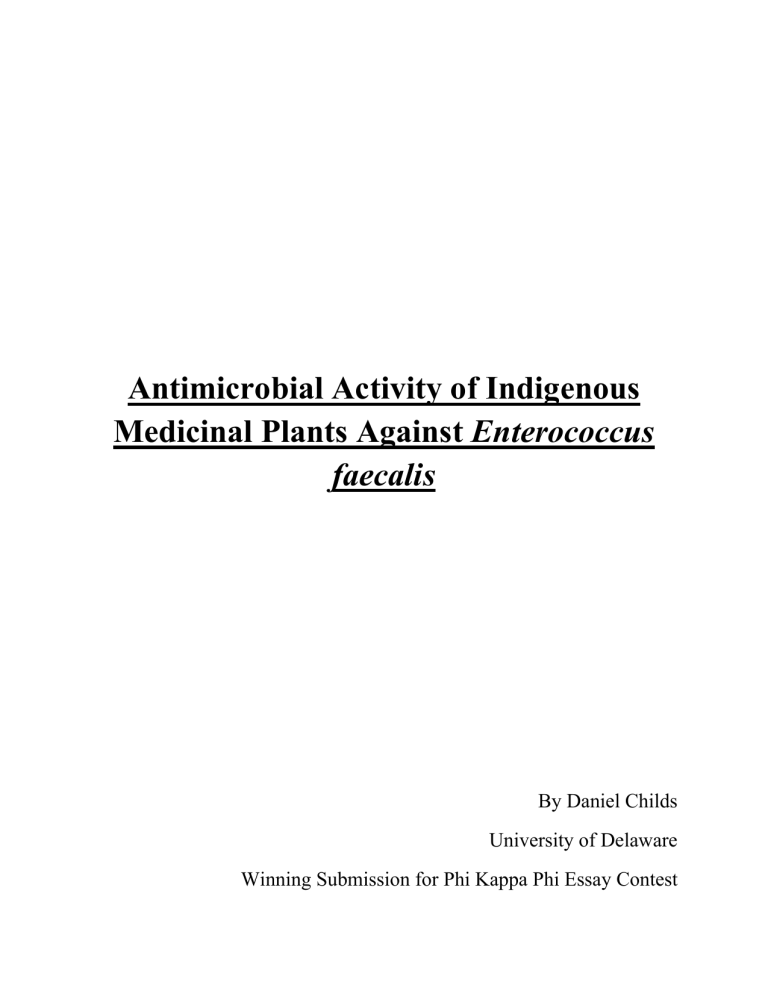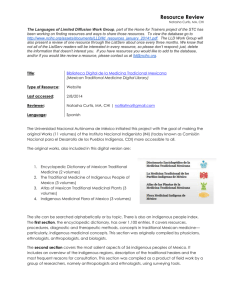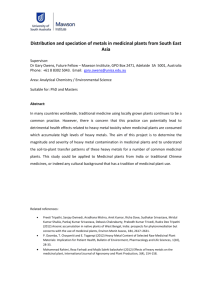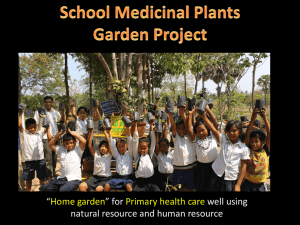Antimicrobial Activity of Indigenous Enterococcus faecalis
advertisement

Antimicrobial Activity of Indigenous Medicinal Plants Against Enterococcus faecalis By Daniel Childs University of Delaware Winning Submission for Phi Kappa Phi Essay Contest Abstract The knowledge of medicinal plant use by indigenous populations constitutes the most understudied medical treatment of the modern world. Utilized by these people for millennia, the scientific community has just recently began to see the legitimacy of their medicinal benefits and has begun to scientifically test them in hopes of discovering their active compounds and the major health ramifications associated with them. However, both the plants themselves and the shamanic knowledge of the plants are fading fast due to destruction of indigenous habitats and the process of acculturation that tribal populations are undergoing. The goal of this study was to travel to three South American tribal groups to document, collect and test the medicinal plants for antibiotic properties. The groups focused on were the Shipibo Indians of the Peruvian Amazon, the Atacameño Indians of the Chilean Atacama Desert, and the Mapuche Indians of the southern, temperate zone of Chile. The collected plants were then tested for antimicrobial activity in a laboratory setting against the antibiotic-resistant pathogen, Enterococcus faecalis. This was accomplished by first performing an antimicrobial assay of the plants and then measuring their effect on the inhibition of bacterial colony formation. Thus far, the Shipibo plants ani boains (Mansoa alliacea) and arabanca (unidentified species) have displayed antibiotic activity against the E. faecalis pathogen. These plants not only help to legitimize indigenous medical practice, but they also have the potential of helping to alleviate one of the largest problems posed to the modern medical community by inhibiting E. faecalis growth. Antimicrobial Activity of Indigenous Medicinal Plants Against Enterococcus faecalis Introduction Enterococcus faecalis was chosen to be the principle pathogen of investigation for this study. E. faecalis is a ubiquitous Gram-positive bacterium that can be found in the gastrointestinal tracts of humans. Gram-positive refers to a test used in the identification of bacteria. If a bacterial species is referred to as Gram-positive, as opposed to Gram-negative, this means that they have a thickened outer cell wall, due to the high amount of a chemical known as peptidoglycan. It is this thickened layer that allows them to retain the purple chemical used in Gram staining, known as crystal violet. Although the bacteria live in the human gastro-intestinal tract, they are still potentially lethal pathogens, especially in hospital environments, causing serious infection in the GI tract of humans. The reason that E. faecalis was chosen is because it presents a significant therapeutic challenge to modern medicine due to their resistance to conventional antibiotic drugs, such as penicillin, ampicillin, and vancomycin (all of which attack the thickened cell walls of these bacteria). This has caused increased pressure on the development of new and alternative therapies in order to mitigate some of the negative health consequences caused by this pathogen (Moellering: 1992). It has been found that E. faecalis can cause infection in the tissues of some plants, eventually causing death (Muller, et. al.: 2001); however, not all plants are susceptible to the harmful effects of this pathogen. Although there is a vast evolutionary gap between plant and animal species, the mechanisms of infection are similar. Therefore, it has been hypothesized that plants which are found to possess antimicrobial effects against E. faecalis infection can also display the same effects in mammalian species as well (Prithiviraj, et. al.:2005). For this reason, I chose to go to those individuals who know the properties of plants better than anyone else: indigenous populations; however, this information is rapidly disappearing, presenting the scientific community with a race against time. Although indigenous people do not classify the plants as possessing chemical compounds that work on specific biochemical pathways the same way the Western world classifies them, they have knowledge of the healing properties associated with these plants, as they have used them for millennia in order to cure disease. The use of medicinal plants by indigenous populations has long been thought to be the practice of witchdoctors with no medical knowledge whatsoever. However, the majority of the scientific community has recently begun to realize that this was just an ethnocentric assumption of the Western world and that their medicinal treatments actually do have merit (Pool and Geissler 2009:8). The famous ethnobotanist Mark J. Plotkin has been known to say that every time a shaman dies, it is as if a library has burnt to the ground. Since these groups are nonliterate, that is, they don’t possess a system of writing (not to be confused with illiterate, where writing is possessed, but they cannot read it), the knowledge of the uses of medicinal plants is entirely oral and passed down from generation to generation. This is relevant now more than ever, as the pressures of the outside world continue to cause tribal people to acculturate to Western civilization and leave their traditional lives behind. With this abandonment of traditional ways, comes the disappearance of traditional knowledge, including medicinal plant use. This, along with the fact that indigenous habitats and the plants found in them are being destroyed, presents the scientific community with a race against time to salvage this knowledge. The goal of my study was to travel to South America to live with three tribal groups in order to salvage some of this knowledge through collecting and documenting their medicinal plants. In addition to this, those plants that I collected were then brought back to the University of Delaware in order to test them in a laboratory setting against the E. faecalis pathogen in hopes of finding an alternative treatment method against this deadly pathogen. I also hope that my research will help bring awareness to the detrimental effects that the destruction of indigenous habitat could bring, as well as inspire members of these tribal groups to take interest in using medicinal plant remedies as their ancestors did. Why South America? I chose to do my fieldwork in South America for three main reasons. The first reason is because the amount of biological diversity in South America is unparalleled. This is due largely in part to the fact that the continent existed as an island continent after it split with Africa and Antartica 105 million years ago, until just five million years ago when a land bridge formed with North America (Roe 2011: Pers. Com). This allowed for a closed evolutionary environment where never before seen species developed, resulting us the wide variety of flora and fauna that we see today. Over time these species would have evolved biological defense mechanisms to defend them from the dangers of their respective environments to better their chances of survival, giving us a wide variety of chemical compounds, most of which have yet to be tested for their medicinal benefits. The second reason that I chose South America was because of the wide range of environments that can be found within the continent. The Andes Mountains, which are the second tallest mountain range in the world after the Himalayas, are the cause of two of the most extreme environments in the world. One such extreme environment is the Atacama Desert, which is the driest desert in the entire world. This is due to the rain shadow caused by the Andes’ towering peaks which do not allow rain clouds to pass. The other extreme byproduct of the Andes is the lushest rainforest in the world, the Amazon rainforest (Moseley 2001: 26). This is a result of the Amazon River, which is fed by glacial melt water from the Andes. In addition to this, you can find everything in between these two extremes in South America. This allowed for plants to not only adapt to the different environments, but it presents the scientific community with the most extreme cases of plant adaptation in the world, in environments like the Amazon Rainforest and the Atacama Desert. The third, and possibly most important, reason that I chose to do my research in South America is that there still are a relatively large number of unacculturated indigenous populations living on the continent, some of which are still being discovered by the Western World. In fact, in mid-January of 2011 a previously uncontacted group was photographed near the PeruvianBrazilian border in the Amazon (BBC News: 2011). This isolation from the modern world allows for preservation of their oral knowledge of plants, as well as very little destruction of the habitats that they have lived in for thousands of years. I chose to study with tribal populations that would represent these two extreme biomes of the jungle and the desert, as well as a group that falls somewhere in the middle in a temperate zone. The groups that I studied with vary in amount of acculturation, but this is something that will be further examined in a different part of this thesis. The groups that I chose to study with were the Shipibo Indians of Peru, the Atacameño Indians of the North of Chile, and the Mapuche Indians of the southern Araucanía zone of Chile. The Shipibo Indians The Shipibo Indians live in the Peruvian branch of the Amazon Rainforest, the wettest and most biodiverse place on the planet. The Amazon has over 80,000 documented species of vascular plants; however, only an estimated 1.4% of this number have been thoroughly tested in a laboratory (Plotkin 1993: 7). Thus, the jungle offers us a modern day pharmacopeia, rich with potential medical cures yet to be discovered by science, making it perfect for this type of study. The Shipibo and their ancestors have lived here for millennia and know the beneficial properties that these plants have to offer. Over the course of three weeks I lived with the Shipibo, documenting their lifestyle, culture, and medicinal plant use, as well as collecting the plants that they showed me. This was done in the both the highland and lowland river basins in the villages of San Francisco de Yarinacocha and Callería. Collections were done in the parts of the jungle untouched by humans, parts of the jungle which have been modified by humans, and the house gardens. This resulted in the collection of 96 medicinal plants, which ended up being by far the most plants collected from any of the three groups that I studied with. The Atacameños The next group I stayed with was the Atacameño Indians located in the north of Chile in the Atacama Desert. The Atacameños live in the driest environment on the planet, receiving on average just .02 inches of rain each year, many years they don’t receive a drop of rain at all. This provided a wonderful contrast to the Amazon, which receives 80 inches of rainfall on average each year; 4,000 times that of the Atacama (Butler 2006 and Armstrong 2011). Documentation and collection was completed in two villages at two different elevation levels: Caspana, located in the highlands, and Toconao, located in the lowlands. The result was a total of 18 medicinal plants collected over a span of around 10 days. The Mapuche The third and final group that I studied with was the Mapuche Indians in the southern, temperate zone of Chile. By temperate, I mean that this zone has four seasons per year: fall, winter, spring, and summer. This gave me a nice midpoint between the extreme environments of the Amazon, where there are only two seasons (the rainy season and the more rainy season) and the Atacama, where there are also only two seasons (the hot and dry season and the cold and dry season). Here, I lived with a Mapuche shaman and his family for one week and I was able to document and collect 23 medicinal plants. In addition to the collection and documentation of plants, my Mapuche shaman informant allowed me to see what traditional shamanic practices would have been like in pre-Colombian times. The reason I was able to see it here, and not so much with the other groups is because the Mapuche Indians have resisted missionary conversion efforts, for the most part, whereas the Shipibo and Atacameño Indians have not been able to, resulting in a loss of traditional shamanic practices. Plant Collection Methodology In total, around 140 medicinal plants were collected and documented. Prior to going I received a USDA permit, which allowed me to transport the dried plant specimens back to the US in order to test them in the lab that I work in. Before going into the process of how the plants were screened, it is important to talk briefly about how they were collected. With each plant I would take a picture, write down the name of the plant in the indigenous language, the common Spanish name, and then I would translate both to English when possible. I would note what type of habitat the plant was found in, what illness the plant was used to cure, how they prepared the plant, and what magical connotations (if any) the plant had. While the concept of magical plants with spirits sounds alien to the Western world, it is important to remember that these people were animists up until recently. This means that every part of their natural world had spirits, and medicinal plant spirits are very important for the shamans, as well as the common tribesmen. The reason for addressing all of this is because the process of screening the plants is very time consuming. In the event that I am not able to test all 140 plants that I collected prior to graduation, I wanted to establish some sort of hierarchy of the plants that I wished to test first. Those plants which were most relevant to our screening were the plants that were used to heal disease commonly associated with E. faecalis, which are gastro-intestinal problems. This included things like stomach ache, diarrhea, vomiting, etc. Next, plants associated with other types of bacterial infection were isolated, such as respiratory illness, wounds, tooth infections, skin infections, sore throat, and so forth. Our next priority was the plants that were used to help with bone and muscular pain. Although these are not typically associated with bacterial infection, they are still used to heal a disease, as defined by the Western biomedical model (Pool and Geissler 2009: 52). Our last priority was the magical plants. This includes those plants that protect you from rival shamans trying to do you harm, those that make you a better hunter, a better fisherman, a better love maker, make your mother-in-law like you, etc. While these are all very important things, they are not “medical problems” in the eyes of Western science. Once this hierarchy was established, the actual testing of the plants could begin. Plant Screening Methodology This process of screening the plants began with grinding the plant part utilized in healing (leaves, flowers, roots, stems, bark etc.) down to a fine powder and making a water solution out of it. After allowing the solution to sit for at least 24 hours, I would return the next day and filter the plant particles from the aqueous mixture, leaving just the water and the active plant compounds. From there, I would plate the plant extracts along with the bacteria to measure bacterial growth. The plates were twelve wells wide, so I would start with a large amount of the plant extract (50%) on the left hand side, and then in subsequent wells to the right I would plate the bacteria with smaller and smaller concentrations of the plant extract (25%, 12.5%, 6.25%, etc.). An equal amount of bacteria (5µL) would then be plated with each of the different concentrations of the plant extracts. The amount of bacterial growth was determined by reading the optical density (OD) of each respective well. This was done through the use of a chemical reagent known as BactGloTM, which illuminates the molecules of adenosine triphosphate (ATP) produced by each living bacterial cell (BacTiter-Glo™ Microbial Cell Viability Assay: 2011) The illuminated ATP molecules allow the machine that reads the OD to quantify the amount of bacteria in each well. The result that you hope to see from this is a linear increase in bacterial population, with very small numbers of bacteria plated with higher concentrations of the plant extract, and larger numbers of bacteria as the concentration of the plant was reduced. This indicates that when the plant is present in sufficient concentrations, bacterial growth is reduced. We would then try to replicate this data using a different test that measures the ability of the plant extracts to inhibit the amount of countable bacterial colonies able to be formed on a plate of media. The goal of the second test was to replicate our data from the first test in a different way, indicating that the first set of data was not mere chance. As can be imagined, this is a very time consuming process and I have thus far only tested 14 of the 140 plants, all of which were Shipibo plants. That being said, two out of these 14 plants have continuously yielded good results. One of these plants is known in Shipibo as ani boains (Mansoa alliacea), while the other one is known as arabanca. Ani boains has yielded very promising results as it has displayed enormous antimicrobial effects on the bacteria in all the screening tests, thus far. Arabanca has not inhibited bacterial growth to such an extent as ani boains, but it is very interesting because it has yet to be identified in any of the literature on Shipibo medicinal plants that I have encountered in my research to this point. Significance of Results Now, what significance does the success of plants like ani boains and arabanca have? As I mentioned before, we chose the bacteria Enterococcus faecalis because it is posing a huge problem to the medical community right now. This is due to its lethality in hospital environments, as well as its resistance to conventional antibiotic treatments. If we can isolate the compounds that these plants possess that make them effective against Enterococcus then we can potentially discover new antibiotics that can be used in the treatment of Enterococci caused illnesses. As for what this means for the tribes to whom the knowledge of these plants belongs, it not only helps to legitimize their understanding of what health benefits their environment has to offer, but it also gives us the potential of being able to channel money back into these groups. This could happen if a pharmaceutical company were to market a drug derived from the compounds of one of these plants, because, after all, these people have the intellectual property rights to the medicinal usage of these plants. Future Directions As for the future direction of the project, in the next year I will finish testing the plants against Enterococcus faecalis. From there, I will test those plants which exhibited success against Enterococcus against a Gram-negative species of antibiotic resistant bacteria, Pseudomonas aeruginosa, as well as a pathogenic fungus from the Candida family in order to see if the plants work against those two disease causing agents as well. Hopefully, we will isolate the active compounds in the plants and present our findings to pharmaceutical companies to try to get these compounds approved for human use in order to save the lives that these pathogens are taking, as well as to give some of the profit back to these groups who mostly belong to the lowest economic class in their respective countries. Additionally, I will be writing an interdisciplinary senior thesis in the fields of anthropology and biology, both of which are my majors. The anthropological chapters will begin by examining the phenomenon of the animistic worldview of tribal societies. This will trace the origins of animism, the extensions of the doctrine into the physical world, and the emergence of a shaman from this dogma. Then, the concept of shamanism will be explored. This includes shamanic vocation, how a shaman obtains his healing powers, how a shaman becomes initiated, instruments and spirits utilized by the shaman during curing rituals, and ultimately how the shaman obtains the knowledge of the plants that he or she uses. Following this, the origins of ethnobotany (the branch of anthropology that my research falls under) will be examined. I will then give a brief historical sketch of all three groups that I worked with. This will include archaeological evidence, the earliest known information taken on these people during the time of Spanish conquest, and finally how these groups exist today in a rapidly changing world. I will then discuss my fieldwork extensively, including informants worked with, my findings, difficulties of the fieldwork, etc. To transition into the biological section I will include an inventory of all of the plants collected with all of the information I collected during fieldwork, as well as the scientific binomials of each, and whether or not they were tested in the laboratory. The biological section will then include information, such as why I chose these pathogens, the procedure of testing the plants, the results, and any other findings. Conclusion The potential benefits of this type of research could have tremendous global impact for a number of reasons. First, the documentation of these plants and the legitimization of the medical practices of tribal populations could not only bring awareness to the Western world about the detrimental effects of habitat destruction, but it also has the potential to influence more members of these tribes to take interest in learning about the ways of their ancestors, thus preserving this medicinal knowledge for future generations. In order to ensure that this knowledge is preserved, I will travel back to all three groups visited and present them with an inventory of their medicinal plants in the Spanish language, along with the name in the indigenous language, pictures, preparation, uses, and habitat. This is known as the “Shamans Apprentice Program”, as conceived by the revolutionary ethnobotanist Mark J. Plotkin (Plotkin; 1993: 18). Additionally, the active chemical compounds of these plants (which presumably have kept tribal people using them for millennia) can be tested against other problematic disease causing agents in the laboratory with the potential of being used as alternative treatments. Also, the potential to alleviate the poverty that most indigenous populations face exists if these alternative treatments are turned into a source of economic gain to honor their intellectual property rights. I am optimistic that my research will inspire more people from the scientific community to do more interdisciplinary research like this in order to help people before it is too late. References Armstrong, Sean. “Atacama Desert.” World Wildlife Fund, 2011. http://www.worldwildlife.org/wildworld/profiles/terrestrial/nt/nt1303_full.html, accessed 20:01, April 17, 2011. BacTiter-Glo™ Microbial Cell Viability Assay. 2011. In Promega©. Retrieved 9:45, April 15, 2011, from http://www.promega.com/products/cell-health/cell-viabilityassays/bactiter_glo-microbial-cell-viability-assay/ “Brazil’s Cerrado”, documentary. Episode, Mutant Planet, Science Channel. January 11, 2011. Bulter, Rhett A. 2006. “Diversities of Image—Rainforest Biodiversity.” Retreieved 19:54, April 17, 2011, from http://rainforests.mongabay.com/0305.htm. Moellering, R. C., Jr. 1992. Emergence of Enterococcus as a significant pathogen. Clinical Infection Diseases. 14:1173. Moseley, Michael E. 2001. The Incas and their Ancestors: The Archaeology of Peru. New York: Thames & Hundson Inc. Muller, T., Ulrich, T., Ott, E.M., and Muller, M. 2001. “Identification of Plant-Associated Enterococci.” Journal of Applied Microbiology. 91:268. Plotkin, Mark J. 1993. Tales of a Shaman’s Apprentice: An Ethnobotanist Searches for New Medicines in the Amazon Rain Forest. New York: Penguin Books. Pool, Robert and Geissler, Wenzel. 2009. Medical Anthropology: Understanding Public Health. New York: Open University Press. Prithiviraj, B., Weir, T., Bais, H.P., Schweizer, H.P. and Vivanco, J.M. 2005. “Plant models for Animal Pathogenesis.” Cell Microbiology. 7: 315. Roe, Peter. G. 2011. Personal communication (classroom). Unidentified Author. “New images of remote Brazil tribe.” BBC News January, 2011. http://www.bbc.co.uk/news/science-environment-12325690, accessed April 15, 2011.






